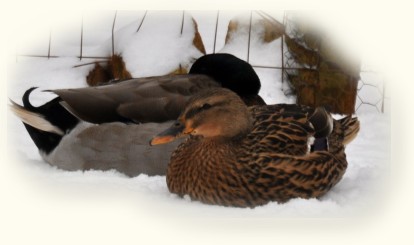|
|
|

|

|
|
DOMESTIC MALLARD DUCKS |
 This wild species frequents most countries in the Northern Hemisphere, and is believed to be the parent stock of all
domestic duck breeds, with the single exception of the Muscovy. Mallards readily adapt to domestication and in four or
five generations of heavy feeding in captivity will increase dramatically in size and lose much of their desire and
ability to fly.
This wild species frequents most countries in the Northern Hemisphere, and is believed to be the parent stock of all
domestic duck breeds, with the single exception of the Muscovy. Mallards readily adapt to domestication and in four or
five generations of heavy feeding in captivity will increase dramatically in size and lose much of their desire and
ability to fly.
The Mallard drake is one of the most beautiful of all waterfowl with his iridescent green head, white neck collar,
chestnut breast, silver underbody, blue wing speculum and reddish-orange feet. Except for her iridescent blue wing speculum,
the hen’s plumage is a mellow, though attractive, combination of almond and golden browns, with dark brown and black penciling.
Along with Muscovies, genuine Mallards are the most self-reliant of all breeds. The hens are outstanding mothers and will hatch
a high percentage of their greenish-buff or bluish eggs if not molested repeatedly while nesting. When there is an abundant
supply of natural foods, hens are capable of raising their broods with little or no supplementary feed.
Dave Holderread. Raising the Home Duck Flock Hatchlings Since 2014: 610 | | CHARACTERISTICS |
| AKA: Green Heads, Flying |
Type: Duck |
Lay Rate: Seasonal |
Egg Size: Medium |
Egg Color: Green |
| Origin: North America |
Nature: Flighty | Hardy: Yes |
Comb: -- |
Source: Ideal |
| Broody: Yes | Rarity: Common | Free Range: Yes | |
| Notes: Capable of full flight. Males will develop a green tinge to bill ~8-9 weeks. |
|
| ROBERTS FARM |
I originally bought Mallard ducklings because I found it amazing that Nature could produce such brilliant colors. It took a little adjustment
figuring out the best way to address their specific needs – they’re messy little creatures. However, a bit of space, a concrete pond, and bowl waterers
took care of any difficulty. They will lay their eggs in protected areas but prefer to range outside even during the coldest, messiest weather. Our mallards
are not the friendliest birds preferring to keep their distance from humans and other poultry, but they are a sight to watch especially when swimming in the pond.
|
|
HATCHING EGGS |
Fertile Mallard duck hatching eggs are usually available during non-peak hatching months, June through August, and are sold in lots of one-half dozen. They may also be available, from time-to-time, during January-May but will incur an additional premium. At this time, we do not ship eggs. For
information on hatching eggs click here to see our Incubation Guide.
The eggs we sell are the same eggs we hatch and are collected and stored in the same manner as the eggs we hatch. However, because of the complex
factors involved in artificial incubation, we make no guarantee of fertility or hatchability. For the 2014 hatch season, 76% of all Mallard eggs set hatched
successfully.
|
|

Calvin & Cindy Roberts
488 County Road 335
San Augustine, Texas 75972
(936) 652-1940 (Text Only)• mail@calvinroberts.us
|
|
DISCLAIMER: Prices, products, and services described on this website may or may not accurately reflect
current prices, products, and services and are subject to change without prior notice. For more current information, please
contact us by telephone or email. Live animals carry risk of salmonella and other diseases and should be handled accordingly
|
|